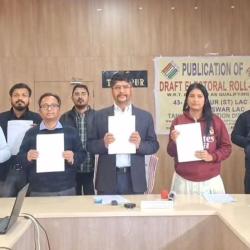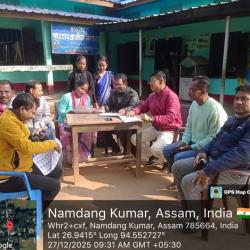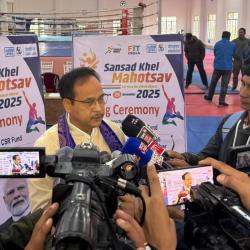NAPM opposes the Indo-US Nuclear deal
NAPM demands immediate closure of the Counter-Insurgency and Jungle Warfare School at Vairengte in Mizoram
Amidst protests against price rises of essential items throughout the country, the Prime Minister Manmohan Singh has again started harping on the issue of the Indo-US Nuclear Deal. Activists of National Alliance of People's Movements (NAPM) - the largest network of people's struggles in India - opposed the deal.
"The Deal has been pushed forward in India in an anti-democratic manner without approval of the Parliament - in fact in the teeth of opposition by a large majority of parliamentarians" said Dr Sandeep Pandey, who is a Ramon Magsaysay Awardee (2002) and a convener of NAPM.
"The Deal has the potential of disturbing regional stability and further distorting India's relationships with important neighbours like China, Pakistan and Iran. This cannot also but severely undermine the prospects for both vertical and horizontal non-proliferation and thereby the prospects for global nuclear disarmament" remarked Medha Patkar, a firebrand leader of Narmada Bachao Andolan (NBA) and also the coordinator of NAPM.
This allurement also has the danger of further propelling India towards becoming a junior military ally of the US and a market to mint profits for its MNCs and also the nuclear industry of other advanced countries -- Russia and France, in particular, said activists.
"Most importantly it will be a set back to the environmentally friendly sustainable ways of meeting our energy requirements. Power from nuclear energy is a failed project in developed countries and the eagerness of the Prime Minister to clinch the Deal fails to generate any enthusiasm among the common people of India. Neither is nuclear energy a solution to global warming as some experts make it out to be. On the contrary the entire nuclear fuel cycle is fraught with danger and exposes human beings to hazardous radiation. The world is yet to find a safe way for disposal of radioactive waste, a factor which is constraining the growth of nuclear power programmes in the developed countries" added Dr Sandeep Pandey, who did his PhD in control theory also applicable in missile technology from University of California, Berkeley in 1980s.
The Indo-US Nuclear Deal is meant to serve the interests of the global nuclear power industry and is a ploy to keep India away from staking claims to shrinking fossil fuel reserves in proportion to its large population so that these reserves may last for some more time for the rich countries, explained the activists.
The undue importance given to the Indo-US Nuclear Deal as opposed to the Iran-Pakistan-India gas pipeline, even though gas is predicted to be the major source of power globally for the next two to three decades, raises questions about the motives of the Indian government.
"We take strong objection to the joint Indo-US military exercises that have been taking place for the last seven years with the aim of building interoperability and we demand immediate closure of the Counter-Insurgency and Jungle Warfare School at Vairengte in Mizoram. The increasing militarization of the India State is also being used to crush civil liberties and democratic movements in the country. India must learn a lesson from the history of US military involvement in various parts of the world" demanded Patkar.
"We appreciate the consistent stand taken by the Left Front, a partner in the UPA alliance, in successfully stalling the Indo-US Nuclear Deal up till now and hope that the India specific agreement with the International Atomic Energy Agency (IAEA) will never be finalized. Even as we note their foresight in foiling the US hegemonic designs in South Asia, we also expect them to take a principled stand against the nuclear power programme. We believe that the IAEA safeguards must be implemented nationally and internationally on all declared and undeclared nuclear activities, including that of Israel and US. The Government of India must also make its nuclear related activities transparent and accountable to the people, especially those who are directly affected by radiation" added Patkar.
Dr Sandeep Pandey also welcomed the government's decision to ask the Ministry of New and Renewable Energy to draft umbrella legislation for promotion and growth of renewable energy.
Other activists who endorsed the opposition on behalf of NAPM included: Surendra Mohan, Achin Vanaik, Major General SG Vombatkere (retd), J Sri Raman, Thomas Kocherry, Sukla Sen, Mukta Srivastava, Anand Patwardhan, Ajit Jha, Feroze Mithiborwala, Kishore Jagtap, PTM Hussain, Ashish Ranjan Jha, Kamayani, Sanjay MG and Arundhati Dhuru.
Other Contents by Author
The smoke-free policies in India were enforced since 2 October 2008 and different states are at varying levels of its implementation, yet the tobacco cessation services are still limited to very few clinics in India.A lead article published in The Economist (7-13 March 2009) says: "tobacco is more addictive than virtually all of them [narcotic drugs]."With tobacco being highly addictive, it is clear that for a successful implementation of the smoke-free policies, the scaling up of high-quality and reliable tobacco cessation services can no longer be ignored."Large areas in central and north-east India have more than 65 per cent tobacco use" said Dr Pratima Murthy, who is the...
On 23 January 2009, the Group of Ministers (GoM) in India will again meet to assuage concerns of tobacco lobby on pictorial warnings, health activists apprehend.This group of ministers (GoM) consists of: Pranab Mukherjee (External Affairs Minister), Kamal Nath (Commerce and Industry Minister), Priyaranjan Dasmunsi (former Information and Broadcasting Minister), S Jaipal Reddy (Urban Development Minister), Dr Anbumani Ramadoss (Health and family welfare Minister), and Oscar Fernandes (labour and employment Minister for state). The pictorial warnings on tobacco products are proven to reduce tobacco consumption. Particularly in countries like India, where literacy rates are alarmingly low, it...
To confront the present war posturing between India and Pakistan, the citizens of both countries are launching a joint signature petition campaign on 9 January 2009, to voice their mandate against terrorism, war posturing and to promote mutual cooperation and peace. This signature petition campaign shall conclude on 8 February 2009, after which these signatures shall be handed over to the heads of both the nations along with other prominent stakeholders. Citizens of both nations can also sign online here or by going to the following URL: http://www.PetitionOnline.com/ indopak/petition.html The petition states that the citizens of Pakistan and India demand that: The Government of Pakistan...
The first patient was successfully treated by the state-of-the-art technology in radiotherapy – linear accelerator, which began functioning last week at RR Cancer Institute and Research Centre, Sri Ram Murti Smarak Institute of Medical Sciences (SRMSIMS), Bareilly in India.A linear accelerator (LINAC) is the device most commonly used for external beam radiation treatments for patients with cancer. The linear accelerator can also be used in stereotactic radiosurgery similar to that achieved using the gamma knife on targets within the brain. The linear accelerator can also be used to treat areas outside of the brain. It delivers a uniform dose of high-energy x-ray to the region of the...
India is reeking under increasing communal polarisation and urgent steps to check it are warranted. Between 24 August and 2 October 2008, more than 300 villages in 14 districts of Orissa state were affected by communal violence. 4,300 houses were burnt and 57 people were killed. 2 women were gang-raped. 149 churches and 13 educational institutions were attacked. In Kartnataka state, 19 churches in 4 districts were attacked and 20 women sustained serious injuries. In other states of India, like in Kerala 3 churches were attacked, in Madhya Pradesh 4 churches were attacked, and one church was attacked in Delhi and Tamil Nadu each. In the state of Uttarakhand, 2 people were killed. In all the...
India has boldly enforced the smoke-free policies banning smoking in public places and private areas with public access from 2 October 2008 – the birth anniversary of the father of nation Mahatma Gandhi.The government of India and countless people who have been advocating the enforcement of public health policies need due credit. It was certainly not so easy, more so because of the financially robust, strategically shrewd tobacco industry that has mastered the art of circumventing public interest policies and promoting a product (tobacco) that kills even when used as intended by the manufacturer.The tobacco industry, and other corporations or associations like ITC ltd, Indian Hotel...
The 3rd edition of the "Global Tobacco Treaty Action Guide 2008: Protecting Against Tobacco Industry Interference" was released earlier this week in many countries including India, during International Week of Resistance (IWR) to tobacco transnationals (22-28 September 2008). The Global Tobacco Treaty Action Guide 2008 is produced by Corporate Accountability International [which is in official relations with the World Health Organization (WHO)], along with the Network for Accountability of Tobacco Transnationals (NATT).The need for IWR was never so acute – when on one hand government of India is resolved to enforce the nation-wide ban on smoking from 2 October 2008, the...
It is a pity that India's robust smoke-free policies have been challenged by those with vested interests neglecting the immense and undisputed proven public health benefits of implementing such policies for people at-large. India is to ban smoking in public places nation-wide from October 2. However the ITC Limited and the Indian Hotel Association are among those who have challenged these public health policies in the court of law. The hearing by the honourable court is due."Secondhand smoke, also know as environmental tobacco smoke (ETS), is a mixture of the smoke given off by the burning end of a cigarette, pipe or cigar and the smoke exhaled from the lungs of smokers. It is...
There is a growing consensus to raise awareness about diabetes in the 50 days leading up to World Diabetes Day on 14 November 2008. The International Diabetes Federation announced that the theme for this year's campaign is "Diabetes in Children and Adolescents."Diabetes is one of the most common chronic diseases to affect children. It can strike children of any age, even toddlers and babies. Every day more than 200 children are diagnosed with type 1 diabetes, requiring them to take multiple daily insulin shots and monitor the glucose levels in their blood. It is increasing at a rate of 3% each year among children and rising even faster in pre-school children at a rate of 5% per year...
All tobacco products will display approved pictorial warnings and nicotine-tar levels from 30 November 2008, as per a notification issued by the Indian Ministry of Health and Family Welfare (dated 27 August 2008), in accordance with the Cigarettes and Other Tobacco Products (Prohibition of advertisement and Regulation of Trade and Commerce, Production, Supply and Distribution) Act, 2003. The implementation of pictorial warnings on tobacco products in India was initially planned for February 2007, but got deferred four times thereon.Grim images of diseased lungs will appear on cigarette, bidi and gutkha packets, as per the notification, covering 40 per cent of the surface area of the tobacco...










Add new comment